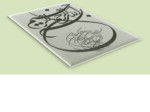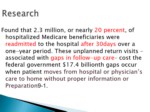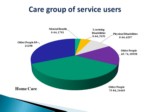بخشی از پاورپوینت
--- پاورپوینت شامل تصاویر میباشد ----
اسلاید 1 :
Home care تعریف مراقبت در منزل
مراقبت در منزل عبارتست از ارائه خدمات بهداشتی و درمانی در محل زندگی بیماران در این سیستم بیمار تحت نظارت پزشک و پرستار در محل زندگی خود از خدمات بهره مند میشود(1-4)
Home care nursing is a specialized area of nursing practice in which the nurse provides care in the
client’s home, school, workplace or other community setting.(1-11)
مدیریت ارائه خدمات بنحوی که بیماران را در قسمتی یا تمام زندگی شخصی توانمند گرداند که این امر با انجام خدمات مراقبتی پیشگیرانه و حاد یا طولانی صورت می گیرد
(Federal/provincial/territorial group on home care 1999)
اسلاید 2 :
افراد حرفه ای ارائه دهنده مراقبت در منزل
Professionals providing home care
- licensed practical nurses
- registered nurses
- home health aides
- physical therapists
- occupational therapists
- social workers
اسلاید 3 :
پرستار عضو کلیدی مراقبت در منزل
طیف وسیعی از کادر بهداشتی خدمات خود را در منزل ارایه می دهند ولی پرستاران ستون اصلی سیستم ارايه دهنده این خدمات را تشکیل می دهندو نقش عمده در هماهنگی و ارایه خدمات بهداشتی در منزل را ایفا می کنند (1-6)
اسلاید 4 :
DEFINITION OF
home care nurse
1-provides medical services where a patient lives---often in one's own home, a family member's home or in an assisted-living community.
Home care nurses may specialize in different areas, including geriatrics, pediatrics and hospice care
2-The scope of practice for nursing is the promotion of health and the assessment of the provision of care for, and the treatment of, health conditions by supportive, preventive, therapeutic, palliative and rehabilitative means in order to attain or maintain optimal function1-8
حیطه عملکرد پرستار عبارت است از ارتقائ بهداشت و ارزیابی تدارک مراقبت و درمان و حفظ شرایط سلامتی بوسیله حمایت ،پیشگیری و درمان و تسکین و توانبخشی ،با هدف دستیابی و حفظ عملکرد مطلوب
اسلاید 5 :
Home care nurse practices
- Teaching about diseases and treatment
- Health Assessments including blood pressure monitoring and other vital signs, glucose monitoring, post operation monitoring and telemonitoring
- Wound care
- Dressing changes
- Ostomy/colostomy teaching and management
- IV management
- Medication reconciliation and reports to doctors or pharmacists
- Medication administration
- Injections
- Heparin flushes
- Foot care
- Management of urinary catheters
- Management of tubes, drains and bags
(www.interimheaith.com)
اسلاید 6 :
شرح وظایف مصوب پرستار خانواده
انجام اقدامات آموزشي– مشاورهاي
بازديد از منزل
تشكيل پرونده بهداشتي– مراقبتي
انجام كليه شرح وظايف عمومي و تخصصي پرستاران در سه سطح پيشگيري، درمان و توانبخشي
ثبت و گزارش موارد و بيماري هايي قابل گزارش
همكاري در انجام پژوهش ها و اخذ آمارهاي بهداشتي ودرماني
ثبت كليه اقدامات آموزشي و مراقبتي انجام شده
(سازمان نظام پرستاری)
اسلاید 7 :
اهمیت انجام مراقبت در منزل
Home care is no longer just about talking to patients, giving baths and taking their blood pressure.
“Our care is The gaps occur when a patient moves from a hospital or physician’s care to home without proper information or preparation
(1-9)
اسلاید 8 :
فواید مراقبت در منزل
افزایش کیفیت مراقبت (9)
کاهش دفعات و زمان بستری در بیماران از جمله بیماران مزمن (9)
پیشگیری از بستری های غیر ضروری با کاهش خطاهای دارویی و سقوط در منزل(9)
کاهش خطر ابتلا به عفونت های بیمارستانی (5)
افزایش راحتی و آسایش بیمار
ایمنی برای بیماران و خانواده های آنان
20 تا 30 % هزینه کمتر از خدمات بیمارستانی (4)
بازگشت سریعتر بیمار به زندگی عادی (5)
افزایش خدمات به بیماران سالمند و نیازمند به مراقبت طولانی
تسریع در ترخیص از بیمارستان و افزایش گردش تخت
اسلاید 9 :
آماربیماران تحت پوشش مراقبت در منزل در آمریکا
In the United States, the home care industry serves
about 8.6 million patients, with needs ranging along
a continuum that includes:
1- primary care
2- pre- acute care intervention
3-post-acute care services
4-hospice
5-palliative care
More than 1 million home health care and hospice employees serve these patients, as well as a home care equipment and services sector with another 250,000 employees.1-9
}
اسلاید 10 :
Research
Found that 2.3 million, or nearly 20 percent, of hospitalized Medicare beneficiaries were readmitted to the hospital after 30days over a one-year period. These unplanned return visits – associated with gaps in follow-up care– cost the federal government $17.4 billionth gaps occur when patient moves from hospital or physician’s care to home without proper information or Preparation1-9.












